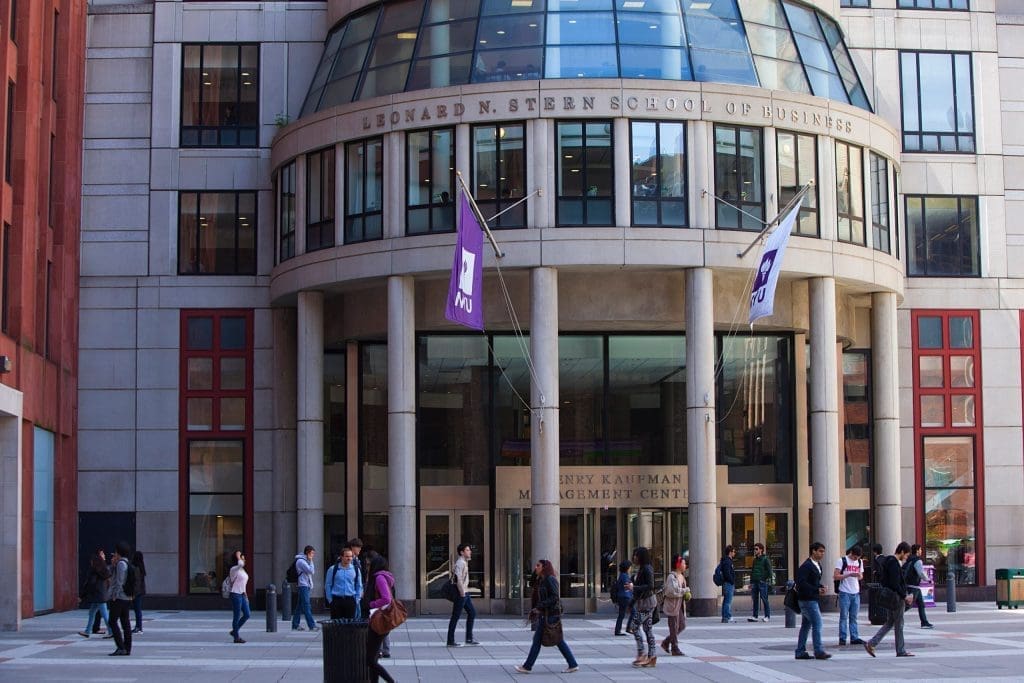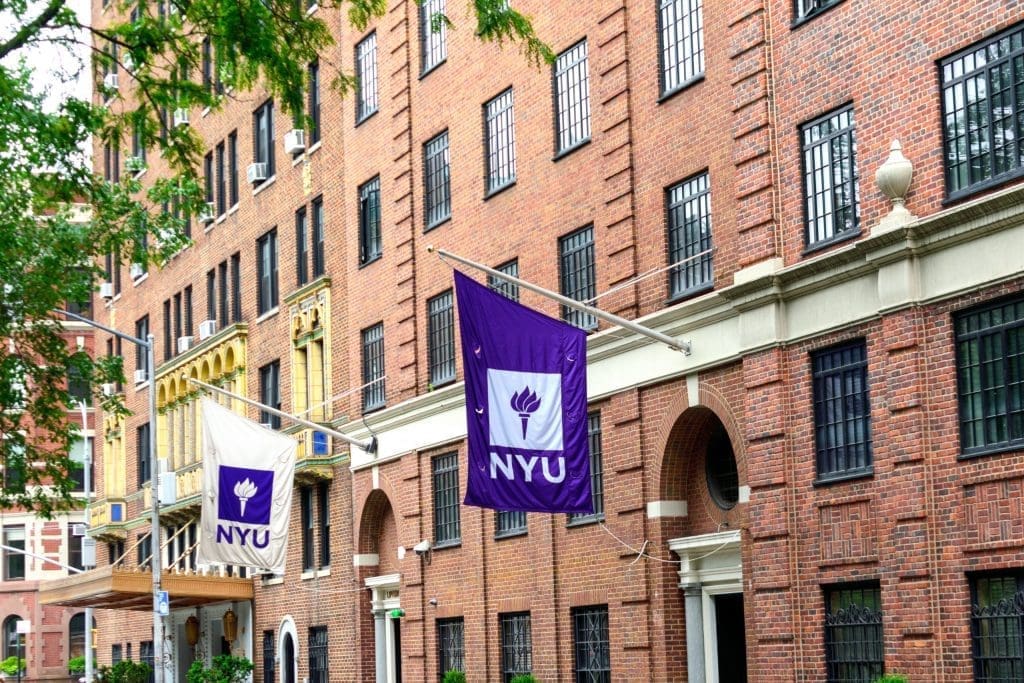Picture yourself walking through Washington Square Park in New York, the heart of NYU’s dynamic and diverse campus. As you walk, students from all corners of the globe gather, exchanging ideas that span cultures, disciplines, and perspectives. At New York University (more commonly called NYU), it’s not just about learning within the classroom—it’s about building connections that shape a truly global community.
This essence of connection lies at the core of NYU’s 2025 supplemental essay prompt. The university seeks “bridge builders”—students who can foster collaboration, span cultural divides, and bring people together in meaningful ways. In an increasingly fragmented world, this ability to connect has never been more important, and showcasing it in your essay will set you apart in the application process.
In this guide, we’ll help you craft a compelling response that reflects your unique experiences and aspirations. Read on to learn how to craft a standout NYU supplemental essay with expert tips, brainstorming strategies, and actionable advice to showcase your bridge-building qualities.
Ready to write your NYU supplemental essays? Today, we’ll cover:
- Understanding the Prompt
- Brainstorming Ideas
- Narrative Tips
- Polish & Editing
- Your Future at NYU
From understanding NYU’s expectations to brainstorming authentic ideas and perfecting your narrative, we’ll review how to write an essay that bridges the gap between your story and your future in the heart of New York City.
I. Understanding the “Bridge Builder” Prompt
Without further ado, here is the 2024-2025 college admission essay prompt for NYU.
Prompt: “In a world where disconnection seems to often prevail, we are looking for students who embody the qualities of bridge builders—students who can connect people, groups, and ideas to span divides, foster understanding, and promote collaboration within a dynamic, interconnected, and vibrant global academic community. We are eager to understand how your experiences have prepared you to build the bridges of the future. Please consider one or more of the following questions in your essay (250 words):
- What personal experiences or challenges have shaped you as a bridge builder?
- How have you been a bridge builder in your school, community, or personal life?
- What specific actions have you taken to build bridges between diverse groups, ideas, or cultures?
- How do you envision being a bridge builder during your time at our university and beyond?”
What Does It Mean?
NYU’s 2024 supplemental essay prompt asks for more than just a recounting of your achievements—it’s an invitation to reflect on your ability to create connections in a world that often feels divided. But what exactly does it mean to be a “bridge builder”?
At its core, being a bridge builder is about fostering understanding and collaboration among people, groups, or ideas that might not otherwise connect. NYU values students who can demonstrate empathy, leadership, and a proactive approach to uniting others. This isn’t just about resolving conflicts; it’s about recognizing and celebrating diversity while working to create a cohesive whole.
For instance, NYU’s campuses in Abu Dhabi, Shanghai, and New York embody its global ethos. If you’ve had experiences engaging with different cultures or perspectives—whether through travel, community service, or even virtual collaborations—tie these to how you’ll thrive in NYU’s dynamic and globally connected environment.
Guiding Questions
To unpack this overarching supplemental essay prompt, NYU provides several helpful guiding questions. Think about moments in your life when you’ve overcome barriers—cultural, social, or personal—to bring people together. Consider specific roles you’ve played in fostering unity, whether through student organizations, volunteer work, or even informal leadership in your friend group.
As you brainstorm, don’t forget to tie in your future aspirations. While your story should highlight your past experiences as a bridge builder, don’t forget to transition to your future. Admissions officers want to see how your skills will enrich NYU’s community and how the university’s resources will help you grow further.
Most of all, be sure to highlight tangible efforts, like organizing an event or leading a project that bridged differences. In essence, this is your chance to tie your personal values to NYU’s mission. How will you contribute to its global, interconnected community?
Tips for Success:
- Go Beyond the Surface: Avoid generic responses like “I love diversity.” Instead, share detailed, personal stories that showcase your unique contributions.
- Stay Authentic: NYU admissions officers value genuine, heartfelt essays over exaggerated or overly polished responses. Write with sincerity.
- Avoid Clichés: Phrases like “bringing people together” are fine in moderation, but they should be backed by vivid examples. Think of moments when your actions truly had an impact.
By fully understanding the prompt, you can craft an essay demonstrating how you’ve built bridges in the past and how you plan to continue doing so at NYU and beyond.

II. Brainstorming and Idea Generation
Crafting a standout supplemental essay for NYU starts with identifying the experiences that truly define you as a “bridge builder.” But how do you uncover those moments?
This section will guide you through a brainstorming process to help you pinpoint meaningful experiences, avoid clichés, and tell a story that resonates.
Step 1: Reflect on Your Past Experiences
Ask yourself the following questions to uncover potential topics that will work well for the NYU supplemental essays:
- When have I brought people together? Think about times you resolved a disagreement, unified a group for a common goal, or helped someone feel included.
- What challenges have shaped me? Reflect on personal struggles—like adapting to a new culture, overcoming prejudice, or navigating different perspectives—that taught you the value of connection.
- How have I fostered understanding? Consider moments where you bridged gaps in knowledge, beliefs, or backgrounds to create harmony or drive collaboration.
Step 2: Map Your Experiences to the Prompt
NYU’s guiding questions can help you align your experiences with what the admissions team is looking for:
- Personal Experiences: Did you grow up in a multilingual household? Have you faced challenges that required bridging cultural or social divides?
- School or Community Roles: Think about leadership roles in clubs, student government, or volunteer work where you brought together diverse groups.
- Specific Actions: Did you start a project that united people? Have you collaborated with others to solve a problem that required multiple perspectives?
- Future Aspirations: How will you leverage these skills at NYU to contribute to its global academic community?
Step 3: Use Prompts to Generate Ideas
To spark inspiration, try these writing prompts:
- Describe a time you helped mediate a conflict between two groups. What did you do to find common ground?
- Think of a project where you worked with people from different backgrounds. How did you unite the team?
- Recall a time you took a risk to stand up for someone or something. How did it impact others?
- Imagine yourself at NYU. What unique perspective will you bring to the campus?
Reminder: Highlight Impact and Growth
When brainstorming, focus on examples that show both impact and personal growth:
- Impact: What tangible results came from your efforts? Did you create lasting change or inspire others?
- Growth: How did the experience shape your values, perspectives, or goals?
Examples of Bridge-Building Experiences for the NYU Essays
Need inspiration? Here are a few scenarios that can serve as strong essay material:
Example 1:
“Growing up as the only bilingual child in a multigenerational household, I often found myself translating more than just words. When my grandparents felt disconnected from our fast-paced, technology-driven family dinners, I created a weekly ‘heritage night,’ where we shared stories from their past over traditional dishes. This small act reconnected our family and taught me the value of fostering understanding through shared experiences.”
- Highlight the challenge and the growth: How did this moment shape your perspective or skills? What lasting impact did it have on you or those around you?
Example 2:
“As editor of my high school newspaper, I noticed that our content rarely reflected the diversity of voices within our school. To address this, I launched a ‘Stories Untold’ series, partnering with students from underrepresented communities to share their perspectives. The series not only boosted readership but also sparked schoolwide conversations about inclusion.”
- Show impact: Did your actions lead to measurable results, positive feedback, or long-term changes?
Example 3:
“During a summer internship with a nonprofit serving immigrant families, I noticed a disconnect between the organization’s staff and the families they served. Drawing from my own experience as a child of Cuban immigrants, I created a bilingual English-Spanish resource guide and organized community events where families could voice their needs directly to the staff. This not only improved communication but also increased participation in the nonprofit’s programs by 25%.”
- Focus on intentional efforts to foster connection. Be specific about what you did, why it mattered, and the outcome.
Example 4:
“At NYU, I’m eager to join the Center for Global Affairs, where I can collaborate with peers from around the world on initiatives addressing cross-cultural challenges. Beyond campus, I hope to leverage my experiences at NYU to pursue a career in diplomacy, building bridges between nations to foster peace and understanding.”
- Research specific programs, clubs, or initiatives at NYU that align with your goals as a bridge builder. Choose examples that are uniquely yours, and avoid generic claims or overused phrases.
For each question, prioritize depth over breadth. By taking the time to brainstorm thoughtfully, you’ll uncover the moments that truly showcase your ability to connect and unite. These stories will form the foundation of a compelling essay.

III. Crafting a Compelling Narrative
Once you’ve identified the experiences you want to highlight, the next step is turning those ideas into a cohesive, compelling essay. A well-structured narrative not only keeps the reader engaged but also ensures your key points are communicated effectively.
Easier said than done, right? Let’s break it down.
Start Strong with an Engaging Opening
Your first few sentences should grab the reader’s attention and set the tone for your essay. Here are some strategies:
- Begin with a vivid anecdote: Start with a specific moment that captures your role as a bridge builder. For instance: “When the debate club split into two factions over a divisive topic, I stepped in—not to take sides, but to design a forum where everyone could express their views without interruptions.”
- Use a surprising statement or statistic: Highlight a key insight that relates to your story, like: “Did you know that 78% of successful group projects rely on effective communication? I learned this firsthand when I brought together student journalists and photographers to produce our high school’s first bilingual yearbook.”
- Pose a thought-provoking question: Capture your reader’s curiosity with a question. For instance: “How do you unite people with conflicting beliefs to achieve a shared goal? I found the answer during a summer internship where I worked with refugees and local youth to organize a cultural exchange event.”
After your opening, introduce a thesis that ties your hook to the prompt. Make clear how your experiences define you as a bridge builder and connect to your aspirations at NYU.
Build the Narrative with Specific Examples
It may sound redundant, but it’s good advice: always use specific examples. Each paragraph should focus on one key experience that supports your thesis. If you’re stuck on where to start, try this structure:
- Set the Scene: Briefly describe the context of your experience.
- Introduce the Challenge: What obstacle or gap were you trying to bridge?
- Detail Your Actions: Explain what you did to foster connection or collaboration.
- Show the Impact: Highlight the tangible results of your efforts and the lessons you learned.
Example:
- Set the Scene: “In my junior year, I joined a student initiative that aimed to reduce food waste in our community.”
- Challenge: “Our team included students from vastly different backgrounds, and our initial meetings devolved into disagreements over priorities—some focused on reducing cafeteria waste, while others wanted to organize food drives.”
- Actions: “I suggested splitting into subgroups that would address both goals while sharing resources. To foster collaboration, I organized weekly check-ins where everyone could share progress and brainstorm solutions.”
- Impact: “By the end of the year, we had reduced cafeteria waste by 40% and distributed over 1,000 pounds of food to local families. More importantly, our team became a model for how diverse perspectives can lead to innovative solutions.”
Incorporate Storytelling Techniques
- Show, Don’t Tell: Instead of saying, “I’m a leader,” describe a moment like: “When our robotics team faced a technical failure hours before a competition, I coordinated an impromptu brainstorming session, leading to a last-minute fix that earned us second place.”
- Use Vivid Language: Paint a picture with sensory details that immerse the reader in your story: “The aroma of freshly baked samosas filled the air as we set up tables for our cultural night, an event that brought together over 300 students from 15 countries.”
- Create a Narrative Arc: Your essay should have a beginning, middle, and end that build toward a meaningful conclusion.
Connect Your Supplemental Essays to NYU’s Resources
Admissions officers love it when applicants show they’ve done their homework. Research specific NYU programs, organizations, or opportunities that align with your aspirations as a bridge builder.
For example:
- If you’re passionate about global collaboration, mention NYU’s Office of Global Inclusion or its satellite campuses.
- For students interested in social impact, highlight NYU’s Wagner School of Public Service or specific service-learning projects.
- Creative writers could connect their experiences to NYU’s renowned Creative Writing Program or its emphasis on interdisciplinary arts.
- If you’re interested in technology and social justice, share how you worked on a coding project that addressed a community challenge and connect it to NYU’s Tandon School of Engineering and its emphasis on socially impactful tech
Further, you’ll want to tie these opportunities back to your personal narrative.
For example: “Having organized a school-wide art exhibit to spotlight underrepresented voices, I’m excited about joining NYU’s Arts and Public Policy program to explore how creative expression can bridge societal divides.”
Close with a Powerful Conclusion
Your conclusion should tie back to your opening and reinforce your role as a bridge builder. Use it to:
- Reflect on how the experience shaped your values and future goals.
- Connect your story to NYU’s unique culture and opportunities.
- End with a forward-looking statement that demonstrates your enthusiasm for contributing to NYU’s global community.
Example:
- “These experiences have shaped my understanding of the impact that bridge builders can have in creating inclusive spaces. At NYU, I look forward to joining student organizations like the Global Spiritual Life program, where I hope to continue building bridges—both within the university and in the wider world.”
By crafting a narrative that’s authentic, specific, and engaging, you’ll make a lasting impression on NYU’s admissions team.

IV. Polishing and Editing
The final stage of writing is just as critical as the brainstorming and drafting process. A polished essay not only demonstrates your writing skills but also shows your attention to detail—qualities NYU values in its applicants.
Checklist for Self-Editing:
- Clarity and Focus: Does your essay answer the prompt directly and stay focused on the “bridge builder” theme?
- Specificity: Have you used concrete examples and vivid details to illustrate your points?
- Authenticity: Does your voice come through, and do your stories feel genuine?
- Structure: Is your essay logically organized, with a clear introduction, body, and conclusion?
Avoid Common Pitfalls:
These pitfalls are common mistakes that show up in lots of college essays. Now, you can avoid them!
- Clichés: Instead of saying, “I’m passionate about connecting people,” show that passion through a story or example.
- Generalizations: Replace vague statements like “I love diversity” with specific experiences that demonstrate your appreciation for different perspectives.
- Overcrowding: Stick to one or two key experiences rather than cramming in too many. Depth is more important than breadth.
Ready for level two? These are specific mistakes that other students tend to make on the NYU supplemental essays in particular. Writers, beware!
- Overly Generic Goals: Avoid vague statements like “I want to build bridges at NYU by working with others.” Instead, detail specific actions you envision taking or NYU initiatives you’d like to join.
- Too Much Focus on the Past: Balance your essay by giving equal weight to your aspirations at NYU and beyond.
- Listing Without Reflection: It’s not enough to mention you’ve bridged cultural gaps or resolved conflicts. Always explain how these experiences shaped your values or prepared you for NYU.
Proofreading Tips:
- Read your essay aloud to catch awkward phrasing or grammatical errors.
- Use online tools like Grammarly for a preliminary grammar check, but don’t rely solely on software.
- Ask a trusted mentor, teacher, or peer for feedback. A fresh perspective can help identify areas for improvement. Professional editors, like Empowerly, can help with this!
A Global Future in New York
Your NYU supplemental essay is a powerful opportunity to showcase your values and fit for NYU’s global community. Remember, admissions officers are looking for students who align with the university’s vision of fostering understanding and collaboration.
If you’re ready to take your essay to the next level, book a consultation with Empowerly’s expert advisors today! We’ll provide personalized feedback and actionable tips to ensure your NYU essay makes a lasting impression. Schedule your session today.
